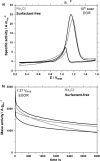Surfactant-Free Colloidal Syntheses of Gold-Based Nanomaterials in Alkaline Water and Mono-alcohol Mixtures
- PMID: 36936178
- PMCID: PMC10018736
- DOI: 10.1021/acs.chemmater.3c00090
Surfactant-Free Colloidal Syntheses of Gold-Based Nanomaterials in Alkaline Water and Mono-alcohol Mixtures
Abstract
Gold nanoparticles (Au NPs) and gold-based nanomaterials combine unique properties relevant for medicine, imaging, optics, sensing, catalysis, and energy conversion. While the Turkevich-Frens and Brust-Schiffrin methods remain the state-of-the-art colloidal syntheses of Au NPs, there is a need for more sustainable and tractable synthetic strategies leading to new model systems. In particular, stabilizers are almost systematically used in colloidal syntheses, but they can be detrimental for fundamental and applied studies. Here, a surfactant-free synthesis of size-controlled colloidal Au NPs stable for months is achieved by the simple reduction of HAuCl4 at room temperature in alkaline solutions of low-viscosity mono-alcohols such as ethanol or methanol and water, without the need for any other additives. Palladium (Pd) and bimetallic Au x Pd y NPs, nanocomposites and multimetallic samples, are also obtained and are readily active (electro)catalysts. The multiple benefits over the state-of-the-art syntheses that this simple synthesis bears for fundamental and applied research are highlighted.
© 2023 The Authors. Published by American Chemical Society.
Conflict of interest statement
The authors declare the following competing financial interest(s): The presented nanotechnology is subject to a patent application. Applicant: University of Copenhagen, Denmark; Inventors: J.Q., K.M.Ø.J.; Application number: EP21193770; Status: Patent filed. The general principle of the surfactant-free synthesis is covered by the patent application.
Figures






References
-
- Daruich De Souza C.; Ribeiro Nogueira B.; Rostelato M. Review of the methodologies used in the synthesis gold nanoparticles by chemical reduction. J. Alloys Compd. 2019, 798, 714–740. 10.1016/j.jallcom.2019.05.153. - DOI
-
- Nasaruddin R. R.; Chen T. K.; Yao Q. F.; Zang S. Q.; Xie J. P. Toward greener synthesis of gold nanomaterials: From biological to biomimetic synthesis. Coord. Chem. Rev. 2021, 426, 213540.10.1016/j.ccr.2020.213540. - DOI
LinkOut - more resources
Full Text Sources
